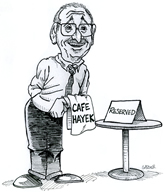… is from page 111 of Anne Krueger’s 2020 book, International Trade: What Everyone Needs to Know:
Advocates of industrial policy believe that there are some promising new industries that are essential to countries and that these should have support (usually in the form of protection) to raise domestic prices and let domestic production be profitable. To my knowledge, no one has ever spelled out what techniques would enable government officials to identify such “winners.”
DBx: And nor to my knowledge has anyone ever given a substantive answer to the question: “How will officials charged with designing and carrying out industrial policy get the information they need both to know which domestic industries and jobs should be artificially buoyed (and, hence, which domestic industries and jobs should be artificially suppressed), and what is the ‘best’ – the lowest-cost – means of performing this artificial industrial buoying and suppression?”
Industrial-policy advocates talk in generalities. Many of them want, for example, to ‘increase manufacturing.’ Sounds nice. But by how much do they want manufacturing to increase? And, more fundamentally, what is manufacturing? Is manufacturing any activity that, by statistical convention, has historically been classified as “manufacturing”? Would a revival of buggy-whip or chamber-pot manufacturers count toward the success of such an industrial policy? (“No, don’t be silly,” answers the industrial policyist.) If not, which particular manufacturing activities are to be encouraged and which are not to be encouraged? (“Industries of the future!” answers the industrial policyist, unaware that he or she is actually so unsure of which industries are and aren’t ‘of the future’ that he or she wants to use government to force resources into whatever industries catch the industrial-policyist’s fancy.)
Industrial policyists believe in miracles.



